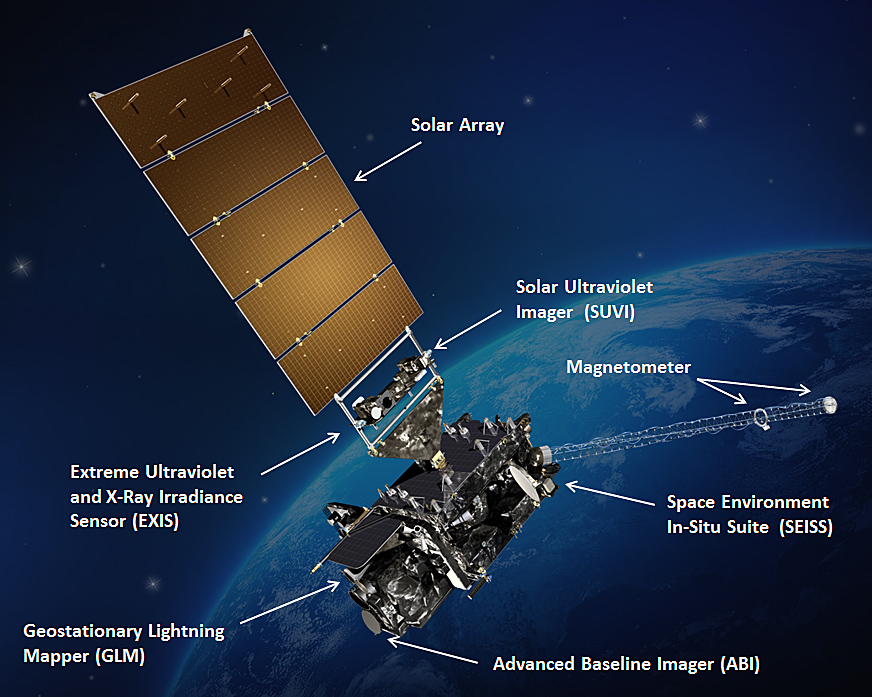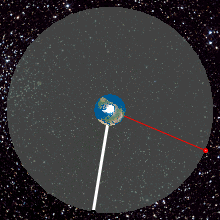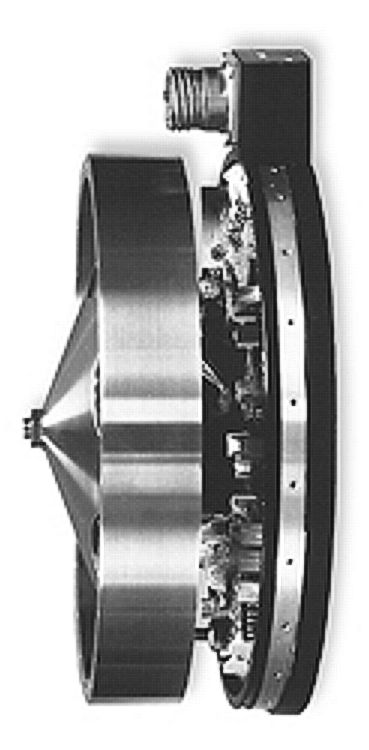|
GOES 9
GOES-9, known as GOES-J before becoming operational, was an American weather satellite, which formed part of the U.S. National Oceanic and Atmospheric Administration's Geostationary Operational Environmental Satellite system. It was launched in 1995, and operated until 2007 when it was retired and boosted to a graveyard orbit. At launch, the satellite had a mass of , and an expected operational lifespan of three years. It was built by Space Systems/Loral, based on the LS-1300 satellite bus, and was the second of five GOES-I series satellites to be launched. Launch GOES-J was launched aboard an International Launch Services Atlas I rocket, flying from Launch Complex 36B at the Cape Canaveral Air Force Station. The launch occurred at 05:52:02 GMT on 23 May 1995. Following launch, it was positioned in geostationary orbit at a longitude of 90° West for on-orbit testing. Once this was complete, it was moved to 135° West, where it assumed GOES-WEST operations. Operations GOES-9 ... [...More Info...] [...Related Items...] OR: [Wikipedia] [Google] [Baidu] |
Weather Satellite
A weather satellite or meteorological satellite is a type of Earth observation satellite that is primarily used to monitor the weather and climate of the Earth. Satellites are mainly of two types: polar orbiting (covering the entire Earth asynchronously) or geostationary (hovering over the same spot on the equator). While primarily used to detect the development and movement of storm systems and other cloud patterns, meteorological satellites can also detect other phenomena such as city lights, fires, effects of pollution, auroras, sand and dust storms, snow cover, ice mapping, boundaries of ocean currents, and energy flows. Other types of environmental information are collected using weather satellites. Weather satellite images helped in monitoring the volcanic ash cloud from Mount St. Helens and activity from other volcanoes such as Mount Etna. Smoke from fires in the western United States such as Colorado and Utah have also been monitored. El Niño and its effects on wea ... [...More Info...] [...Related Items...] OR: [Wikipedia] [Google] [Baidu] |
Geostationary Orbit
A geostationary orbit, also referred to as a geosynchronous equatorial orbit''Geostationary orbit'' and ''Geosynchronous (equatorial) orbit'' are used somewhat interchangeably in sources. (GEO), is a circular orbit, circular geosynchronous orbit in altitude above Earth's equator, in radius from Earth's center, and following the retrograde and prograde motion, direction of Earth's rotation. An object in such an orbit has an orbital period equal to Earth's rotational period, one sidereal time, sidereal day, and so to ground observers it appears motionless, in a fixed position in the sky. The concept of a geostationary orbit was popularised by the science fiction writer Arthur C. Clarke in the 1940s as a way to revolutionise telecommunications, and the first satellite to be placed in this kind of orbit was launched in 1963. Communications satellites are often placed in a geostationary orbit so that Earth-based satellite dish, satellite antennas do not have to rotate to track t ... [...More Info...] [...Related Items...] OR: [Wikipedia] [Google] [Baidu] |
Spacecraft Launched In 1995
A spacecraft is a vehicle that is designed to fly and operate in outer space. Spacecraft are used for a variety of purposes, including communications, Earth observation, meteorology, navigation, space colonization, planetary exploration, and transportation of humans and cargo. All spacecraft except single-stage-to-orbit vehicles cannot get into space on their own, and require a launch vehicle (carrier rocket). On a sub-orbital spaceflight, a space vehicle enters space and then returns to the surface without having gained sufficient energy or velocity to make a full Earth orbit. For orbital spaceflights, spacecraft enter closed orbits around the Earth or around other celestial bodies. Spacecraft used for human spaceflight carry people on board as crew or passengers from start or on orbit (space stations) only, whereas those used for robotic space missions operate either autonomously or telerobotically. Robotic spacecraft used to support scientific research are space prob ... [...More Info...] [...Related Items...] OR: [Wikipedia] [Google] [Baidu] |
List Of GOES Satellites ...
This is a list of Geostationary Operational Environmental Satellites. GOES spacecraft are operated by the United States National Oceanic and Atmospheric Administration, with NASA responsible for research and development, and later procurement of spacecraft. Imagery File:First image from GOES Spac0041.jpg, SMS-derived File:Img-1989-09-19-18-GOE-7-IR.jpg, First-generation File:BW Goes8vis1big.png, Second-generation File:BW 060622_goes13_medium.gif, Third-generation File:GOES 4th Generation full disk imagery.png, Fourth-generation File:GOES-18 full disk GeoColor image from May 5, 2022.png, Fourth-generation Satellites References {{spaceflight lists and timelines * GOES The Geostationary Operational Environmental Satellite (GOES), operated by the United States' National Oceanic and Atmospheric Administration (NOAA)'s National Environmental Satellite, Data, and Information Service division, supports weather fo ... [...More Info...] [...Related Items...] OR: [Wikipedia] [Google] [Baidu] |
1995 In Spaceflight
This article outlines notable events occurring in 1995 in spaceflight, including major launches and EVAs. First Shuttle-''Mir'' mission Orbital launches , colspan="8", January , - , colspan="8", February , - , colspan="8", March , - , colspan="8", April , - , colspan="8", May , - , colspan="8", June , - , colspan="8", July , - , colspan="8", August , - , colspan="8", September , - , colspan="8", October , - , colspan="8", November , - , colspan="8", December , - Suborbital launches , colspan=8, January-March , - , colspan=8, April-June , - , colspan=8, July-September , - , colspan=8, October-December , - Deep Space Rendezvous EVAs References Footnotes {{Orbital launches in 1995 Spaceflight by year ... [...More Info...] [...Related Items...] OR: [Wikipedia] [Google] [Baidu] |
Multi-Functional Transport Satellite
Multifunctional Transport Satellites (MTSAT) were a series of weather and aviation control satellites. They were replaced by Himawari 8 on 7 July 2015. They were geostationary satellites owned and operated by the Japanese Ministry of Land, Infrastructure, Transport and Tourism (MLIT) and the Japan Meteorological Agency (JMA), and provide coverage for the hemisphere centred on 140.0° East; this includes Japan and Australia who are the principal users of the satellite imagery that MTSAT provides. They replace the GMS-5 satellite, also known as ''Himawari 5'' ("himawari" or "ひまわり" meaning "sunflower"). They can provide imagery in five wavelength bands — visible and four infrared, including the water vapour channel. The visible light camera has a resolution of 1 km; the infrared cameras have 4 km (resolution is lower away from the equator at 140° East). The spacecraft have a planned lifespan of five years. MTSAT-1 and 1R were built by Space Systems/Loral. MT ... [...More Info...] [...Related Items...] OR: [Wikipedia] [Google] [Baidu] |
Geostationary Meteorological Satellite
A weather satellite or meteorological satellite is a type of Earth observation satellite that is primarily used to monitor the weather and climate of the Earth. Satellites are mainly of two types: polar orbiting (covering the entire Earth asynchronously) or geostationary (hovering over the same spot on the equator). While primarily used to detect the development and movement of storm systems and other cloud patterns, meteorological satellites can also detect other phenomena such as city lights, fires, effects of pollution, auroras, sand and dust storms, snow cover, ice mapping, boundaries of ocean currents, and energy flows. Other types of environmental information are collected using weather satellites. Weather satellite images helped in monitoring the volcanic ash cloud from Mount St. Helens and activity from other volcanoes such as Mount Etna. Smoke from fires in the western United States such as Colorado and Utah have also been monitored. El Niño and its effects on weat ... [...More Info...] [...Related Items...] OR: [Wikipedia] [Google] [Baidu] |
Japan Meteorological Agency
The Japan Meteorological Agency (JMA; ''気象庁, Kishō-chō'') is a division of the Ministry of Land, Infrastructure, Transport and Tourism dedicated to the Scientific, scientific observation and research of natural phenomena. Headquartered in Minato, Tokyo the government agency, agency collects data on meteorology, hydrology, seismology, volcanology, and other related fields. The JMA is responsible for collecting and disseminating weather data and Forecasting, forecasts to the public, as well as providing specialized information for aviation and Marine weather forecasting, marine sectors. Additionally, the JMA issues warnings for volcanic eruptions and is integral to the nationwide Earthquake Early Warning (Japan), Earthquake Early Warning (EEW) system. As one of the Regional Specialized Meteorological Centers designated by the World Meteorological Organization (WMO), the JMA also Forecasting, forecasts, Tropical cyclone naming, names, and distributes warnings for tropical ... [...More Info...] [...Related Items...] OR: [Wikipedia] [Google] [Baidu] |
Noise
Noise is sound, chiefly unwanted, unintentional, or harmful sound considered unpleasant, loud, or disruptive to mental or hearing faculties. From a physics standpoint, there is no distinction between noise and desired sound, as both are vibrations through a medium, such as air or water. The difference arises when the brain receives and perceives a sound. Acoustic noise is any sound in the acoustic domain, either deliberate (e.g., music or speech) or unintended. In contrast, noise in electronics may not be audible to the human ear and may require instruments for detection. In audio engineering, noise can refer to the unwanted residual electronic noise signal that gives rise to acoustic noise heard as a hiss. This signal noise is commonly measured using A-weighting or ITU-R 468 weighting. In experimental sciences, noise can refer to any random fluctuations of data that hinders perception of a signal. Measurement Sound is measured based on the amplitude and frequency of ... [...More Info...] [...Related Items...] OR: [Wikipedia] [Google] [Baidu] |
Reaction Wheels
A reaction wheel (RW) is an electric motor attached to a flywheel, which, when its rotation speed is changed, causes a counter-rotation proportionately through conservation of angular momentum. A reaction wheel can rotate only around its center of mass; it is not capable of moving from one place to another ( translational force). Reaction wheels are used primarily by spacecraft for three-axis attitude control, and do not require rockets or external applicators of torque, which reduces the mass fraction needed for fuel. They provide a high pointing accuracy, and are particularly useful when the spacecraft must be rotated by very small amounts, such as keeping a telescope pointed at a star. A reaction wheel is sometimes operated at a constant (or near-constant) rotation speed, to provide a satellite with a large amount of stored angular momentum. Doing so alters the spacecraft's rotational dynamics so that disturbance torques perpendicular to one axis of the satellite (the axis p ... [...More Info...] [...Related Items...] OR: [Wikipedia] [Google] [Baidu] |
GOES 10
GOES-10, known as GOES-K before becoming operational, was an American weather satellite, which formed part of the US National Oceanic and Atmospheric Administration's Geostationary Operational Environmental Satellite system. It was launched in 1997, and after completing operations as part of the main GOES system, it was kept online as a backup spacecraft until December 2009, providing coverage of South America as GOES-SOUTH, and being used to assist with hurricane predictions for North America. It was retired and maneuvered to a graveyard orbit on 1 December 2009. Launch GOES-K was launched aboard an International Launch Services Atlas I rocket, flying from Launch Complex 36B at the Cape Canaveral Air Force Station. The launch occurred at 05:49 GMT on 25 April. Its launch was the final flight of the Atlas I rocket, which was retired in favour of the modernised Atlas II. At launch, the satellite had a mass of , and an expected operational lifespan of five years. It was built by ... [...More Info...] [...Related Items...] OR: [Wikipedia] [Google] [Baidu] |
GOES 8
GOES-8, known as GOES-I before becoming operational, was an American weather satellite, which formed part of the US National Oceanic and Atmospheric Administration, National Oceanic and Atmospheric Administration's Geostationary Operational Environmental Satellite system. It was launched in 1994, and operated until 2004 when it was retired and boosted to a graveyard orbit. At launch, the satellite had a mass of , and an expected operational lifespan of three or five years. It was built by Space Systems/Loral, based on the LS-1300 satellite bus, and was the first of five GOES-I series satellites to be launched. Launch GOES-I was launched aboard a Martin Marietta Atlas I rocket, flying from Spaceport Florida Launch Complex 36, Launch Complex 36B at the Cape Canaveral Air Force Station. The launch occurred at 06:04 GMT on 13 April 1994, and placed the satellite into a geosynchronous transfer orbit. It was then raised into geostationary orbit by means of an R-4D-11 apogee motor. During ... [...More Info...] [...Related Items...] OR: [Wikipedia] [Google] [Baidu] |








